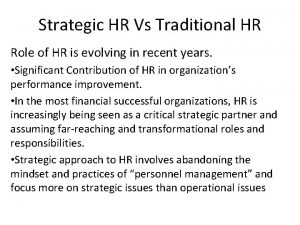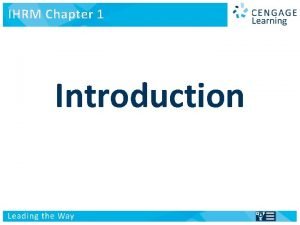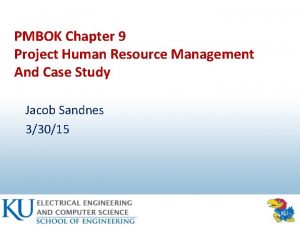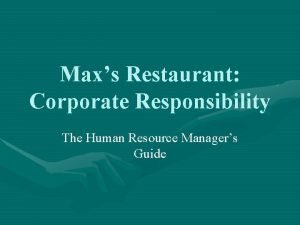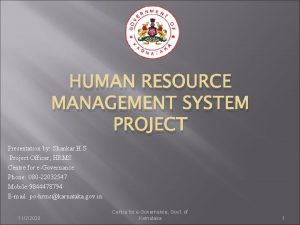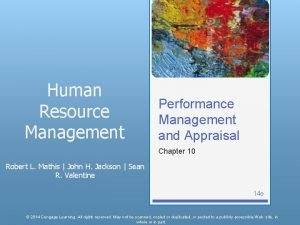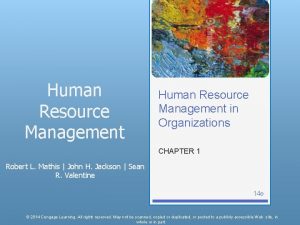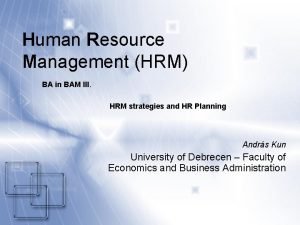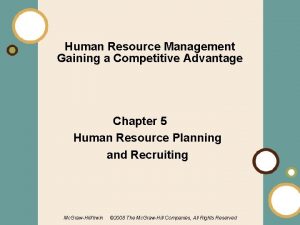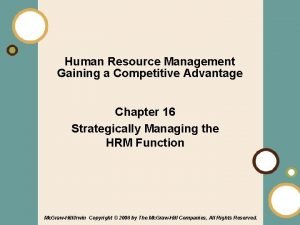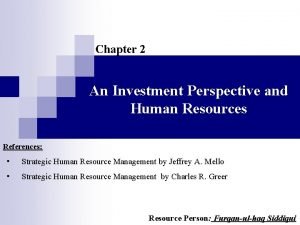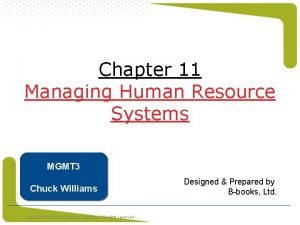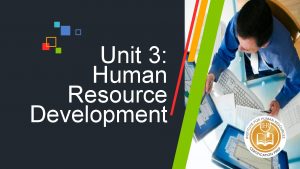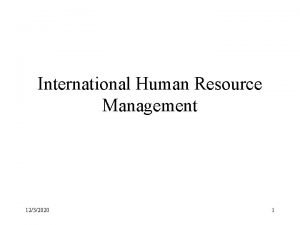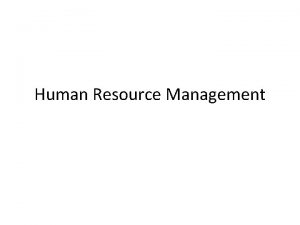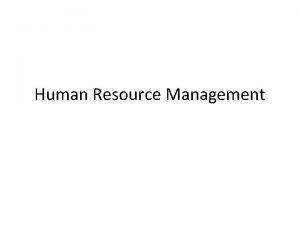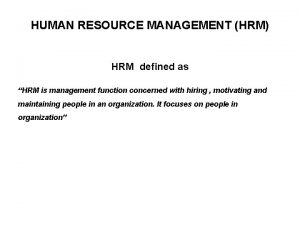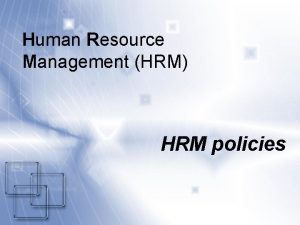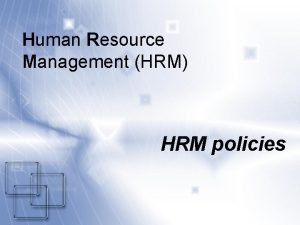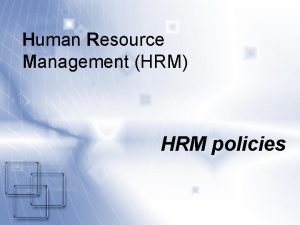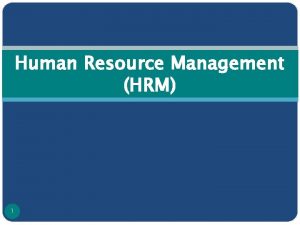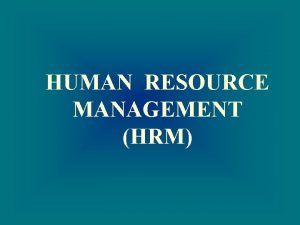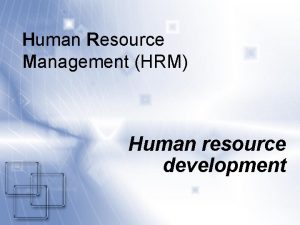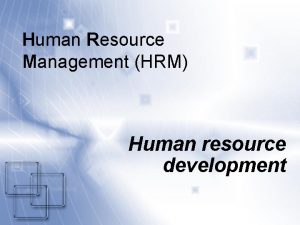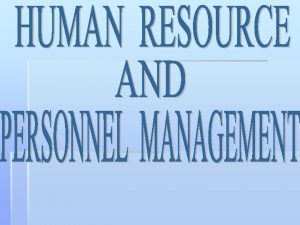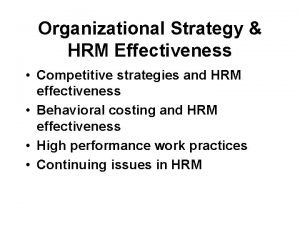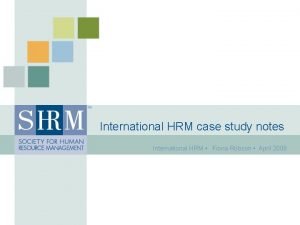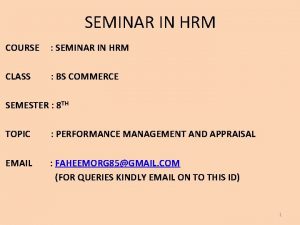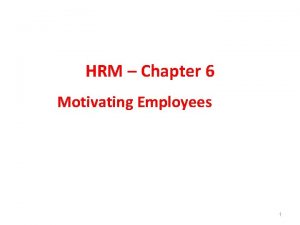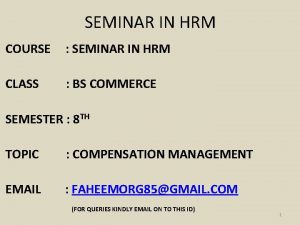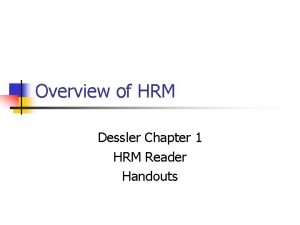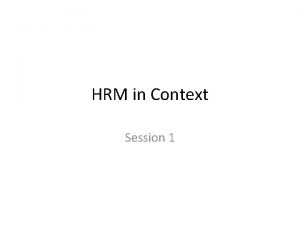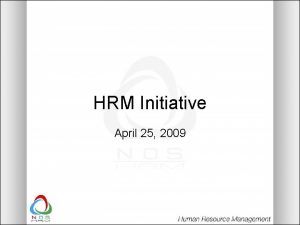HUMAN RESOURCE MANAGEMENT HRM Human Resource Management HRM





































- Slides: 37

HUMAN RESOURCE MANAGEMENT (HRM)

Human Resource Management (HRM) involves the planning, acquisition, and development of human resources necessary for organizational success. People are valuable resources requiring careful nurturing. HRM recognizes that employees are only one group among several, such as customers and shareholders, who have a claim on the resources of the organization. Today, staffing function is just one part of the more encompassing human resource management process.

STAFFING

Keeping the jobs filled with the right people is a crucial task that must be expertly performed by the manager at every level. Staffing refers to the task of filling positions in the organization with the most qualified people available.

The Staffing Process

The staffing function consists of the following steps:

(A) Personnel Acquisition • Human resource planning • Need assessment – job analysis, job description and job specification • Recruitment of applicants for job • Selection of the best qualified • Orientation of the new personnel

(B) Personnel Retention • Performance appraisal • Transfer and promotion • Training and development

HUMAN RESOURCE PLANNING (HRP)

Human resource planning helps management find the right people for the right jobs at the right time. Human resource planning is the development of a comprehensive staffing strategy for meeting the organization’s future human resource needs.

Human resource planning involves objective and systematic assessment of present staffing needs of an organization. It also involves identifying the available personnel to satisfy the current needs, forecasting the future demand supply of employees, formulating staffing strategies, and continuously monitoring, evaluating and updating these needs and resources.

NEED ASSESSMENT No meaningful forecasting and formulation of staffing strategies can take place until management has a clear picture of the organization’s current staffing situation. The organization has to analyze the job by preparing job description and job specification.

Job Analysis – Job analysis is the procedure for determining the duties and skill requirements of a job and the kind of person who should be hired for it. Job analysis produces information used for writing job descriptions and job specifications. Job description and job specification are two tangible products of job analysis.

• Job Description – Job description is a list of a job’s duties, responsibilities, reporting relationships, working conditions, and supervisory responsibilities. It is a list of what the job entails. • • Job Specification – This is a list of a job’s “human requirements”, which includes required education, skills, personality, etc. It tells what kind of people to be hired for the job.

RECRUITMENT The effectiveness of an organization largely depends on the caliber or quality of its employees. The availability of a competent and effective labor force does not just happen by chance. It is due to a well-articulated recruitment exercise.

What is Recruitment? Recruitment is the process of identifying and attracting capable applicants to apply for employment. The process begins when new recruits are sought and ends when applications are submitted.

Sources of Recruitment There are basically two sources of supply from where the potential employees can be drawn. They are: Internal and external sources.

Internal Recruitment This is the process of attracting current employees to apply for higher level jobs in the organization. In any recruitment exercise, it is advisable to first look inward for qualified or potentially qualified candidates to fill particular posts within the organization. There are basically three methods of filling job vacancies internally. They are: Transferring, Promoting, and Upgrading. Whenever a vacancy occurs, someone from the organization is upgraded, promoted or transferred to another department or location. Occasionally, a person may be demoted to fill a job. Most organizations have procedures for announcing vacancies through bulletin boards, Newsletters, word of mouth or personal recommendations.

Advantages of Internal Recruitment • It acts as an incentive and motivates employees to work harder for more responsible and challenging positions within the organization. • It reinforces a sense of loyalty among employees, for it provides them an opportunity for advancement. • It is economical in terms of time and money, since the energy expanded in the process of hiring new candidates from outside is avoided. • It assists the organization in utilizing available human resources fully. • It can help retain high performing individuals who might otherwise leave if there were no advancement opportunity.

Disadvantages of Internal Recruitment • It discourages new blood from entering the organization which may be more innovative and creative. • There may be inadequate supply of qualified applicants from within. • Promotion may be biased in nature and may be based on seniority rather than merit. • An insider may be less likely to make the essential criticisms required to make the company work more effectively. • There may be morale problems among those who are not promoted, i. e. , the promotion of one person in an organization may upset someone else.

External Recruitment • • • • This is the process of attracting individuals from outside the organization to apply for job in the organization. Most organizations cannot fill their manpower needs from sources within and hence they must look for outside sources, especially for lower entry jobs, for expansion, and for positions whose specific requirements cannot be met by people within the organization. This outside pool of potential candidates includes: New entrants to the work-force. These may be University students who have just graduated and are entering the job market. The Unemployed. These are the people who may be temporarily out of job, with skills and abilities. They may also be people who are currently at jobs that are unsuitable to them and who may be looking for better opportunities. Retired experienced persons. These may be accountants, mechanics, security guards, etc. They have the necessary experience and may be hired as consultants or supervisors.

• External sources of recruitment • Media advertisement: Radio, TV, Newspaper, Magazines, etc. • Public and private employment agencies • Educational Institutions • Employee referrals • Walk-ins and write-ins • Unsolicited applications • Labor unions • Billboards at social and community centers

• Advantages of External Recruitment • New blood, new ideas and new perspectives are injected into the organization. • It covers a larger pool of candidates than internal recruitment. • Disadvantages of External Recruitment • The person selected may not fit the job. • It may cause morale problems for those internal candidates of the organization. • It involves higher costs, longer adjustment or orientation time for those employed from outside the organization.

• SELECTION • Selection often follows immediately after recruitment because the ultimate objective of recruitment exercise is to select persons who are most capable of doing the job. • Selection is the process of identifying (from the pool of those recruited) the applicants with the best requirements for the job, and choosing the best individuals for the job. It is a process of choosing the right candidate from a pool of applicants or those recruited.

• • • Selection Process Setting up selection criteria Screening applications (short-listing) Inviting the short listed candidates for interview Interviewing or testing before interview Calling for referees’ reports on the appointable candidates (reference checks) Management’s approval Sending out appointment letters, indicating the conditions of the appointment Medical examination Placement on the job – This is the assignment of an employee to positions in an organization.

• Employee orientation provides new employees with the basic background information required to perform their jobs satisfactorily, such as information about company rules. We should not underestimate orientation’s importance because, without basic information on things like rules and policies, new employees may make time consuming or even dangerous errors. Orientation helps new employees to easily adjust, adopt and fit into their new work environment and settle down to business with minimum difficulties and discomfort.

• Reasons for Employee Orientation • To create in the new employee an initial favorable impression of the organization and its work • To ease the new employee’s entry into the work group by reducing his anxiety and enhancing interpersonal acceptance and trust, and removing feelings of insecurity and lack of confidence. • To help new employees feel at home quickly • To reduce cost of excessive labor turnover • To provide specific information concerning the task and performance expectation of a job.

PERFORMANCE APPRAISAL • The evaluation of the performance of employees is a key part of the function of staffing. Both the managers and the subordinates want to know the quality of their performance. The evaluation serves as a basis for judging the contributions and weaknesses of employees so that continuing effort can be made to build a stronger and more effective organization.

What is Performance appraisal? • Performance appraisal is the systematic examination, evaluation and description of employees’ performance as to how well they are doing or have done their jobs. • • Performance appraisal is a systematic way of evaluating a worker’s performance and his potential for development. • • Performance appraisal compares each employee’s actual performance with his performance standards. It points out individual’s job-relevant strength and weaknesses.

PROMOTION AND TRANSFER Promotion and transfer are integral parts of most people’s career. Promotion refers to advancement or movement to position of increased responsibility and higher prestige. It also means moving an employee to a job that involves higher pay, higher status, and higher performance requirement. Transfer is reassignment to similar (or higher) positions in other parts of the firm. It also means moving an employee to another job at approximately the same level in the organization, with basically the same pay, performance requirement, and safety.

A promotion is an upward move while a transfer is a horizontal move, both within the organizational hierarchy. Most people look forward to promotion, which usually mean more pay, responsibility, and (often) job satisfaction. Promotion can provide opportunity to reward exceptional performance, and to fill open positions with tested and loyal employees.

• TRAINING AND DEVELOPMENT • Recruiting and selecting high-potential employees does not guarantee they will perform effectively. Employees need to know what they need to do and how to do it. If not, they will do the job their own way, improvise, or do nothing productive at all.

Training is planned organizational efforts or activities concerned with helping employee acquire specific and immediately useable skills, knowledge, concepts, attitudes and behavior to enable him perform more efficiently and effectively on his present job. Examples of training needs: the need to have efficiency and safety in the operation of particular machines or equipment; the need for an effective sales force; and the need for competent management in the organization.

Development is planned activities which focus on increasing and enlarging the capabilities of employees. They are learning opportunities designed to help employees grow. Development can also be seen as any activity directed towards future needs rather than present needs, and which is concerned more with career growth than immediate performance. Examples of development needs: the need for managers to be able to utilize the facilities offered by microcomputers in the operation of the business; the need for replacing senior staff with potential candidates from within the organization; and the need for preparing employee to accept change.

ORIENTATION • After recruiting and selecting employees, the next step is to ensure that they know what to do and how to do it. Employee orientation is a planned process of introducing recently employed individuals or existing employees who have been promoted or transferred to different units, to their jobs, co-workers, departments, the polices, rules, objectives and services of the organization and the organization as a whole. It is a procedure for providing new employees with basic background information about the firm.

NEED ASSESSMENT No meaningful forecasting and formulation of staffing strategies can take place until management has a clear picture of the organization’s current staffing situation. The organization has to analyze the job by preparing job description and job specification. • Job Analysis – Job analysis is the procedure for determining the duties and skill requirements of a job and the kind of person who should be hired for it. Job analysis produces information used for writing job descriptions and job specifications. Job description and job specification are two tangible products of job analysis. • Job Description – Job description is a list of a job’s duties, responsibilities, reporting relationships, working conditions, and supervisory responsibilities. It is a list of what the job entails. • Job Specification – This is a list of a job’s “human requirements”, which includes required education, skills, personality, etc. It tells what kind of people to be hired for the job.

• Advantages of Training and Development • Increased knowledge, skills, and the development of positive behavior and attitude to work. • Increased organizational productivity and quality of products. • Reduced turnover rate among workers. • Improved employee motivation • Enhanced employee’s chance of promotion and personal growth. • Reduced supervision from the supervisors. • Greater customer satisfaction. • Competitive edge. • Public recognition
 Difference between traditional hr and strategic hr
Difference between traditional hr and strategic hr International human resource planning
International human resource planning Time management in human resource management
Time management in human resource management Retail organization
Retail organization Management is universal and everywhere
Management is universal and everywhere Project human resource management pmbok ppt
Project human resource management pmbok ppt Resource management pmbok
Resource management pmbok Explain the importance
Explain the importance Restaurant human resources
Restaurant human resources Definition of induction in hrm
Definition of induction in hrm Hrm chapter 2
Hrm chapter 2 Chapter 9 human resources management
Chapter 9 human resources management Hrms shanker group
Hrms shanker group Performance appraisal in human resource management
Performance appraisal in human resource management Current issues in human resource management
Current issues in human resource management Ba human resource management
Ba human resource management Higher business technology in human resources
Higher business technology in human resources Human resource management gaining a competitive advantage
Human resource management gaining a competitive advantage Downsizing
Downsizing Human resource management gaining a competitive advantage
Human resource management gaining a competitive advantage Hrm past exam papers with answers
Hrm past exam papers with answers Performance appraisal in human resource management
Performance appraisal in human resource management Human resource management lecture chapter 1
Human resource management lecture chapter 1 Human resource management by gary dessler 11th edition
Human resource management by gary dessler 11th edition Human resource management strategy and analysis
Human resource management strategy and analysis Utilitarian organization
Utilitarian organization Chapter 11 human resource management
Chapter 11 human resource management Chapter 1 introduction to human resource management
Chapter 1 introduction to human resource management Human resources management chapter 1
Human resources management chapter 1 Applied psychology in human resource management
Applied psychology in human resource management Foundation of hrm
Foundation of hrm Unit 3 human resource management
Unit 3 human resource management Separation in human resource management
Separation in human resource management Human resources and job design
Human resources and job design International human resource management definition
International human resource management definition Human resource management weiterbildung
Human resource management weiterbildung Human resource management syllabus harvard
Human resource management syllabus harvard 5p model of hrm
5p model of hrm
